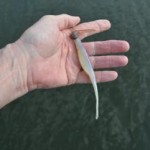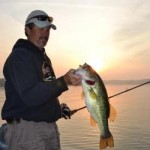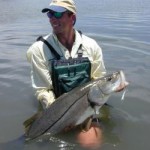Wobble-Jigs
This specialty bait is sometimes the only one you need.
By Frank Sargeant
from The Fishing Wire
What might be called “wobble-jigs” or bladed swim jigs are the ace in the hole of many expert anglers. They perform as a combo of crankbait, swimbait and swimjig, with a bit of spinnerbait flash and buzzbait clatter thrown in on some versions.
The Scrounger features a plastic collar that causes the lure to wobble. Other wobble jigs have a metal plate ahead of the jig head.The lures have accounted for two major national tournament wins already this spring, one at Florida’s Lake Okeechobee, the other just this past Sunday at South Carolina’s Lake Hartwell. Clearly, for pre-spawn and post-spawn bass, these lures have got what it takes.
The lures are basically a jig with something extra, either a metal plate or a plastic lip that makes them wobble when retrieved steadily. The Z-Man Chatterbait, the BooYah Boogee Bait, the Strike King Pure Poison and the Choo-Choo Lures Shaker are all designed with metal plates at the head of the jig that wobble and flash and cause the trailer to swim like mad. The Luck-E-Strike Scrounger is somewhat different-it’s a jig with a flexible plastic collar-but it still has the same wild action.
When dressed with a swimming soft-plastic tail, all of these lures come to life with a remarkably fishy wiggle–sort of swimbaits on steroids–and in many lakes when conditions are right, the bass kill them.
Quality bass like this one captured by Guntersville guide Mike Carter at sunrise are suckers for wobble jigs in spring.The lures have a wobble similar to a crankbait, but since they sink rapidly, it’s easier to get them down to where the fish are and keep them there-without extremely long casts, thin lines or rapid retrieves.
The single hook of these lures means they’re much less likely to pick up weeds or to get snagged than a standard treble-hook crankbait, and are also easier on fish you tend to release. And for bouncing off hard cover, the shovel-like wobbling plate works like the bill of a crankbait.
Wobble-jig fans agree, one key to success with these lures is to use a tail of the appropriate size-too big and you don’t get an adequate wiggle, too small and the profile of the lure is less attractive to quality fish. Another factor is retrieve speed. Too slow and you don’t get the rapid wobble that draws the bites, too fast and some versions simply roll over and plane to the surface. As with a crankbait, the rod will tell you when the speed is right-the perfect speed is the one with the most resistance.
The classic Chatterbait-apparently the original of the genre–is a 4.5 inch lure dressed with plastic skirt, available in weights of 5/8 to ¼ ounce. A slightly longer version, the Chatterbait Trailer in 3/8 ounce, has added length to the skirt, while the Chatterbait Pro has an added nylon weedguard, twin rattles and oversized reflective eyes. The lure also comes in skirtless models with baitfish profiles on swimming plastic bodies.
The single hook jigs stick and hold, but do less damage to fish than treble hook lures and are also easier to remove.
The Booyah Boogee Bait has a couple of interesting innovations, including a spring-like flex zone in the hook shank which the company says will help to prevent fish from shaking the lure. The Boogee Bait also has the longest hook shank of the four bladed baits, aimed at sticking short-strikers. Also unique, says company spokesman Lawrence Taylor, the wobbling plate sits on a clip-release allowing you to quickly change swim-jig bodies without retying the line to the plate.
Lake Guntersville guide Mike Carter is a big fan of the
“You get the swimming action without the extra hardware up front, and when the fish want a more subtle presentation, the Scrounger does the job,” says Carter. He fishes the lures in heads from 3/8 ounce for shallow water to 3/4 for water up to 8 feet deep–any deeper and he switches to a standard jig or crankbait.
In short, there are lots of options when it comes to using wobble-jigs. Tie one on one of your working rods this spring-you may be surprised at how it adds to your catch.
CONTACTS
Booyah Baits: www.booyahbaits.com
Choo-Choo Lures: www.choochoolures.com
Luck-E-Strike: www.luck-e-strike.us
Strike King: www.strikeking.com
Z-Man: www.zmanfishing.com


